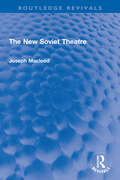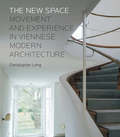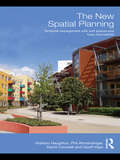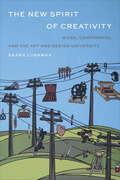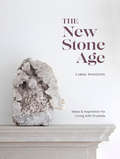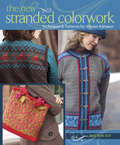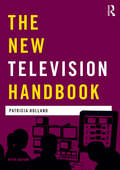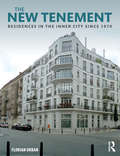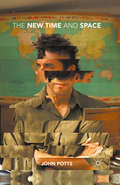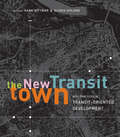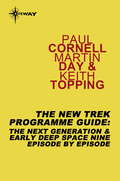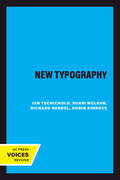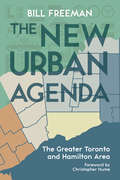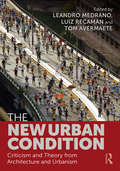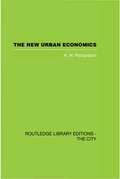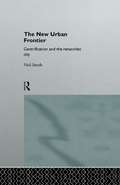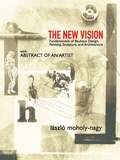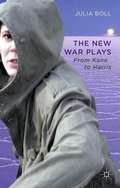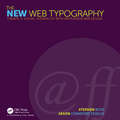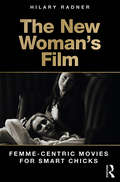- Table View
- List View
The New Soviet Theatre (Routledge Revivals)
by Joseph MacleodFirst Published in 1943, The New Soviet Theatre presents Joseph Macleod’s take on the development and rapid changes in the Soviet Theatre since late 1930s. Through scattered articles and reports, books and bulletins, and his own visits to the USSR, Macleod showcases what we know as ‘Socialist Realism’. He brings themes like the shortcomings of the old theatre; the audience beyond the Caucasus; new socialist audiences; Alexey Popov of the Central Theatre of the Red Army; new writers and new plays; and popularity of Shakespeare both in the central theatres and in remoter and unexpected places. Written graphically but founded on scholarship this book will be an essential read for scholars and researchers of history of theatre, European theatre, theatre and performance studies.
The New Space: Movement and Experience in Viennese Modern Architecture
by Christopher LongScholars have long stressed the problem of ornament and expression when considering Viennese modernism. By the first decade of the 20th century, however, the avant-garde had shifted its focus from the surface to the interior. Adolf Loos (1870-1933), together with Josef Frank (1885-1967) and Oskar Strnad (1879-1935), led this generation of architects to interpret modernism through culture and lifestyle. They were interested in the experience of architectural space: how it could be navigated, inhabited, and designed to reflect the modern way of life while also offering respite from it. The New Space traces the theoretical conversation about space carried out in the writings and built works of Loos, Frank, and Strnad over four decades. The three ultimately explored what Le Corbusier would later--independently--term the architectural promenade. Lavishly illustrated with new photography and architectural plans, this important book enhances our understanding of the development of modernism and of architectural theory and practice.
The New Spatial Planning: Territorial Management with Soft Spaces and Fuzzy Boundaries
by Philip Allmendinger Geoff Vigar Graham Haughton David CounsellSpatial planning, strongly advocated by government and the profession, is intended to be more holistic, more strategic, more inclusive, more integrative and more attuned to sustainable development than previous approaches. In what the authors refer to as the New Spatial Planning, there is a fairly rapidly evolving maturity and sophistication in how strategies are developed and produced. Crucially, the authors argue that the reworked boundaries of spatial planning means that to understand it we need to look as much outside the formal system of practices of ‘planning’ as within it. Using a rich empirical resource base, this book takes a critical look at recent practices to see whether the new spatial planning is having the kinds of impacts its advocates would wish. Contributing to theoretical debates in planning, state restructuring and governance, it also outlines and critiques the contemporary practice of spatial planning. This book will have a place on the shelves of researchers and students interested in urban/regional studies, politics and planning studies.
The New Spirit of Creativity: Work, Compromise, and the Art and Design University
by Saara LiinamaaThe New Spirit of Creativity examines creativity as an embedded institutional value and priority within public art institutions and higher education. The book unpacks the everyday work, organization, and administration of artistic creativity and its clashes with a "new spirit" of creativity that has widely taken hold. Based on fieldwork conducted at three art and design universities in Canada, Saara Liinamaa tackles the fraught landscape of contemporary higher education, the uncertainties of cultural work, and ongoing concerns around austerity in Canada. This book traces how creativity is not simply practiced within the art school, but also inequitably recognized and rewarded. Liinamaa identifies the many compromises required between artistic creativity and the new spirit, while demonstrating how not all compromises are created equally; compromise can support or erode creative diversity. Drawing on a range of original sources – including interviews, participant observation, policy and planning, and media – this work makes a compelling case as to why art and design schools are worthy of sustained attention. By connecting shared interests across sociology, education, cultural studies, art history, and cultural theory, The New Spirit of Creativity makes a novel and agenda-setting contribution to our understanding of artistic creativity, compromise, and cultural work.
The New Stone Age: Ideas and Inspiration for Living with Crystals
by Carol WooltonA fashion-forward guide to living well with crystals from the jewelry editor of British Vogue—including guidance and advice from designers, jewelers, and celebrity crystal fans.The New Stone Age guides you through fifteen different types of stones, categorized by color, and teaches you how to stylishly incorporate them into your wardrobe, home, and beyond. Assigning each crystal to a particular ailment of the modern age, whether it&’s self-doubt, travel anxiety, or restlessness, Carol Woolton explains how a simple crystal worn around your neck, tossed in your purse, or sitting next to your computer can help inspire you to make positive changes in your life. Woolton traces the history of crystals, showing how the same quartz that was used as a form of protection in the handles of Egyptian daggers can also be hung near a bedside to help with burnout. Filled with insights, facts, and real-life stories from people who attribute dramatic personal improvements to their crystals, The New Stone Age is a fun and informative idea book for crystal lovers everywhere.
The New Stranded Colorwork: Techniques and Patterns for Vibrant Knitwear
by Mary Scott HuffClassic Norwegian knitting techniques are reinvigorated with a modern twist in this clear and concise handbook to stranded colorwork. Featuring 20 innovative and fun projects - such as the Lotus Blossom Vest, the Go for Baroque Tote, the Counting Crows Pullover, and the Wedding Belle Cardigan - this guide accompanies each with detailed instructional outlines in the tutorial section and is perfect for a variety of skill levels. Going beyond the usual snowflake and reindeer motifs of traditional Norwegian patterns, this modern resource addresses a niche few other knitting guides have explored and offers a technique section that is enjoyable thanks to its conversational tone. Advanced techniques are also highlighted, such as managing two balls of yarn, adding steeks, and finishing cut edges.
The New Street Photographers Manifesto: Any Camera, Anywhere
by Tanya NagarWhether you shoot with a digital SLR, a Holga or the camera on your phone, today's cameras let you seize the moment and shoot whenever and wherever you like. This makes them perfect for street photography, the genre of choice of some of the greatest photographers of all time, with names like Henri Cartier-Bresson, Weegee and Robert Frank turning gritty reality into iconic images.In this book, Tanya Nagar will open your eyes to the photographic potential of your urban world environment, offering the tricks and techniques that put you in the right place, at the right time, and let you create amazing photos. In addition to everything that'll give you the right skills and headspace to capture great images on the street, Nagar has brought together a stunning showcase of some of the greatest emerging street photographers of our age to inspire you.
The New Street Photographers Manifesto: Any Camera, Anywhere
by Tanya NagarHit the streets with your camera and capture life in all its excitementWhether you shoot with a digital SLR, a Holga or the camera on your phone, today's cameras let you seize the moment and shoot whenever and wherever you like. This makes them perfect for street photography, the genre of choice of some of the greatest photographers of all time, with names like Henri Cartier-Bresson, Weegee and Robert Frank turning gritty reality into iconic images.In this book, Tanya Nagar will open your eyes to the photographic potential of our urban world, offering the tricks and techniques that put you in the right place, at the right time, and let you create amazing photos.
The New Television Handbook (Media Practice)
by Patricia HollandThe New Television Handbook?provides an exploration of the theory and practice of television at a time when the medium is undergoing radical changes. The book looks at television from the perspective of someone new to the industry, and explores the place of the medium within a?constantly changing digital landscape. This title discusses key skills involved in television production, including: producing, production management, directing, camera, sound, editing and visual effects. Each of these activities is placed within a wider context as it traces the production process from commissioning to post-production. The book outlines the broad political and economic context of the television industry. It gives an account of television genres, in particular narrative, factual programmes and news, and it considers the academic discipline of media studies and the ways in which theorists have analysed and tried to understand the medium. It points to the interplay of theory and practice as it draws on the history of the medium and observes the ways in which the past continues to influence and invigorate the present. The New Television Handbook?includes: contributions from practitioners ranging from established producers to new entrants; a comprehensive list of key texts and television programmes; a revised glossary of specialist terms; a section on training and ways of getting into the industry. By combining theory, real-world advice and a detailed overview of the industry and its history,?The New Television Handbook?is an ideal guide for students of media and television studies and young professionals entering the television industry.
The New Tenement: Residences in the Inner City Since 1970
by Florian UrbanThis book examines "new tenements"—dense, medium-rise, multi-storey residences that have been the backbone of European inner-city regeneration since the 1970s and came with a new positive view on urban living. Focusing principally on Berlin, Copenhagen, Glasgow, Rotterdam, and Vienna, it relates architectural design to an evolving intellectual framework that mixed anti-modernist criticism with nostalgic images and strategic goals, and absorbed ideas about the city as a generator of creativity, locale of democratic debate, and object of personal identification.This book analyses new tenements in the context of the post-functionalist city and its mixed-use neighbourhoods, redeveloped industrial sites and regenerated waterfronts. It demonstrates that these buildings are both generators and outcome of an urban environment characterised by information exchange rather than industrial production, individual expression rather than mass culture, visible history rather than comprehensive renewal, and conspicuous difference rather than egalitarianism. It also shows that new tenements evolved under a welfare state that all over Europe has come under pressure, but still to a certain degree balances and controls heterogeneity and economic disparities.
The New Time and Space
by John PottsIn the networked age, we are living with changed parameters of time and space. Mobile networked communication fosters a form of virtual time and space, which is super-imposed onto territorial space. Time is increasingly composed of interruptions and distractions, as smartphone users are overwhelmed by messages.
The New Traditional Woodworker: From Tool Set to Skill Set to Mind Set
by Jim TolpinWorking Wood, Not Machining It If you're more interested in working with wood rather than machining it, you will be relieved to learn that expensive powered machinery isn't required to build furniture. You can also forget the dust masks, face shields and hearing protection since many of the safety concerns related to woodworking-the use of power tools-are eliminated. In this book, you'll learn to set up a hand-tool woodworking shop, then discover the toolset, practice the skillset, and understand the mindset-effectively completing a comprehensive course in hand-tool woodworking.
The New Transit Town: Best Practices In Transit-Oriented Development
by Hank Dittmar Gloria OhlandTransit-oriented development (TOD) seeks to maximize access to mass transit and nonmotorized transportation with centrally located rail or bus stations surrounded by relatively high-density commercial and residential development. New Urbanists and smart growth proponents have embraced the concept and interest in TOD is growing, both in the United States and around the world.New Transit Town brings together leading experts in planning, transportation, and sustainable design--including Scott Bernstein, Peter Calthorpe, Jim Daisa, Sharon Feigon, Ellen Greenberg, David Hoyt, Dennis Leach, and Shelley Poticha--to examine the first generation of TOD projects and derive lessons for the next generation. It offers topic chapters that provide detailed discussion of key issues along with case studies that present an in-depth look at specific projects. Topics examined include:*the history of projects and the appeal of this form of development*a taxonomy of TOD projects appropriate for different contexts and scales*the planning, policy and regulatory framework of "successful" projects*obstacles to financing and strategies for overcoming those obstacles*issues surrounding traffic and parking*the roles of all the actors involved and the resources available to them*performance measures that can be used to evaluate outcomesNew Transit Town explores the key challenges to transit-oriented development, examines the lessons learned from the first generation of projects, and uses a systematic examination and analysis of a broad spectrum of projects to set standards for the next generation. It is a vital new source of information for anyone interested in urban and regional planning and development, including planners, developers, community groups, transit agency staff, and finance professionals.
The New Trek Programme Guide: The Next Generation & Early Deep Space Nine Episode by Episode
by Paul Cornell Keith Topping Martin DaySTAR TREK is one of the world's most popular and enduring science fiction franchises, spanning decades' worth of TV, film, comics, books and more. This book - originally published just as DEEP SPACE NINE was first being produced - analyses the rebirth and renaissance of the series in the nineteen eighties and nineties.Along with masses of factual information - plot synopses, cast and crew and, uniquely, British transmission dates - this Programme Guide casts a gently critical eye over the series' continuity (and lack of it) and lingers over the moments of humour (intentional and otherwise).In sum, this is a light-hearted, detailed and affectionate overview of the revitalised version of the classic STAR TREK. Please note that it has not been updated since its original publication.
The New Typography
by Jan TschicholdSince its initial publication in Berlin in 1928, Jan Tschichold's The New Typography has been recognized as the definitive treatise on book and graphic design in the machine age. First published in English in 1995, with an excellent introduction by Robin Kinross, this new edition includes a foreword by Rich Hendel, who considers current thinking about Tschichold's life and work.
The New Urban Agenda: The Greater Toronto and Hamilton Area
by Bill Freeman Christopher Hume2015 Speaker's Book Award — Shortlisted City planning in the GTHA has been mired in political grandstanding for the past decade, The New Urban Agenda offers a plain language solution to the issues plaguing the GTHA. Politics in the Greater Toronto, Hamilton Area (GTHA) have become increasingly divisive over the past decade, and solutions to the city’s problems have become hot-topic issues debated in council and the press, but never finding resolution.The New Urban Agenda is equal parts history, social science, and call to action to solve the major problems facing the GTHA. Issues such as urban and suburban development, transit, the region’s environmental impact, affordable housing, and the seemingly inherent gridlock of municipal politics are all discussed. Award-winning author Bill Freeman offers a level-headed approach to the problems and lays out an agenda that will lead to an improvement in the quality of life in our neighbourhoods and downtowns and make our cities more economically viable. He encourages individuals and communities to speak up for themselves and get involved in politics at a grassroots level. With no shortage of examples, he shows how this strategy can create the change that is needed to move cities forward in a way that benefits everyone, not just the business and political elite.
The New Urban Condition: Criticism and Theory from Architecture and Urbanism
by Leandro Medrano; Luiz Recaman; Tom AvermaeteThis book explores new architectural and design perspectives on the contemporary urban condition. While architects and urban designers have long maintained that their actions, drawings, and buildings are “post-critical,” this book seeks to expand the critical dimension of architecture and urbanism. In a series of historical and theoretical studies, this book examines how the materialities, forms, and practices of architecture and urban design can act as a critique towards the new urban condition. It proposes not only new concepts and theories but also instruments of analysis and reflection to better understand the current counter-hegemonic tendencies in both disciplinary strategies and appropriation tactics. The diversely international selection of chapters, from Brazil, Portugal, Spain, Sweden, the United States, and the Netherlands, combine different theoretical and empirical perspectives into a new analysis of the city and architecture. Demonstrating the need for new critical urban and architectural thinking that engages with the challenges and processes of the contemporary urban condition, this volume will be a thought-provoking read for academics and students in architecture, urban design, geography, political science, and more.
The New Urban Frontier: Gentrification and the Revanchist City
by Neil SmithWhy have so many central and inner cities in Europe, North America and Australia been so radically revamped in the last three decades, converting urban decay into new chic? Will the process continue in the twenty-first century or has it ended? What does this mean for the people who live there? Can they do anything about it? This book challenges conventional wisdom, which holds gentrification to be the simple outcome of new middle-class tastes and a demand for urban living. It reveals gentrification as part of a much larger shift in the political economy and culture of the late twentieth century. Documenting in gritty detail the conflicts that gentrification brings to the new urban 'frontiers', the author explores the interconnections of urban policy, patterns of investment, eviction, and homelessness. The failure of liberal urban policy and the end of the 1980s financial boom have made the end-of-the-century city a darker and more dangerous place. Public policy and the private market are conspiring against minorities, working people, the poor, and the homeless as never before. In the emerging revanchist city, gentrification has become part of this policy of revenge.
The New Vision: Fundamentals of Bauhaus Design, Painting, Sculpture, and Architecture
by Daphne M. Hoffmann László Moholy-NagyOne of the most important schools for architecture, design, and art in the 20th century, the Weimar Bauhaus included in its distinguished membership Moholy-Nagy. This book, a valuable introduction to the Bauhaus movement, is generously illustrated with examples of students' experiments and typical contemporary achievements. The text also contains an autobiographical sketch.
The New War Plays: From Kane to Harris
by Julia BollHow can war be represented on stage? How does the theatre examine the structures leading to violence and war and explore their transformation of societies? Springing from the discussion about 'New Wars' in the age of globalisation, this interdisciplinary study demonstrates how these 'New Wars' bring forth new plays about war.
The New Web Typography: Create a Visual Hierarchy with Responsive Web Design
by Stephen Boss Jason Cranford TeagueWith a vast selection of typefaces now available, there is no excuse for using boring typography in web design. The New Web Typography: Create a Visual Hierarchy with Responsive Web Design shows you how to implement web-safe fonts to create visually appealing and multi-browser-friendly websites while encouraging you to develop designs that express your own unique typographic voice. <P><P>This book discusses general principles for choosing typefaces for on-screen display and tips for creating a visual hierarchy that works on monitors, tablets, and smartphones. It shares some of the authors’ personal experiences to illustrate situations where one font would be more effective than another in giving readers an optimized experience that includes quick download times and an overall aesthetically pleasing presentation. <P><P>Since good typography is good web design, font selection is a critical aspect of web design. The New Web Typography is more than a simple overview of web typography. It provides practical advice and examples that help you make good decisions in choosing fonts for web design. <P><P>Key Features <li>Demonstrates how to implement responsive web typography, with up-to-date HTML5 and CSS3 code <li>Uses case studies and examples to enhance instruction <li>Provides practical tips on special techniques for implementing webfonts and searching and using webfont libraries <li>Encourages you to develop a unique typographic voice
The New Wine Rules: A Genuinely Helpful Guide to Everything You Need to Know
by Jon BonneThere are few greater pleasures in life than enjoying a wonderful glass of wine. So why does finding and choosing one you like seem so stressful? Now, becoming a happier, more confident wine drinker is easy. The first step is to forget all the useless, needlessly complicated stuff the “experts” have been telling you. In The New Wine Rules, acclaimed wine writer Jon Bonné explains everything you need to know in simple, beautifully illustrated, easy-to-digest tidbits. And the news is good! For example: A wine’s price rarely reflects its quality. You can drink rosé any time of year. Don’t save a great bottle for anything more than a rainy day.
The New Woman's Film: Femme-centric Movies for Smart Chicks
by Hilary RadnerWith the chick flick arguably in decline, film scholars may well ask: what has become of the woman’s film? Little attention has been paid to the proliferation of films, often from the independent sector, that do not sit comfortably in either the category of popular culture or that of high art––films that are perhaps the corollary of the middle-brow novel, or "smart-chick flicks". This book seeks to fill this void by focusing on the steady stream of films about and for women that emerge out of independent American and European cinema, and that are designed to address an international female audience. The new woman's film as a genre includes narratives with strong ties to the woman’s film of classical Hollywood while constituting a new distinctive cycle of female-centered films that in many ways continue the project of second-wave feminism, albeit in a modified form. Topics addressed include: The Bridges of Madison County (Clint Eastwood, 1995); the feature-length films of Nicole Holofcener, 1996-2013; the film roles of Tilda Swinton; Rachel Getting Married (Jonathan Demme, 2008); Blue Jasmine (Woody Allen, 2013); Frances Ha (Noah Baumbach, 2012), Belle (Amma Asante, 2013), Fifty Shades of Grey (Sam Taylor-Johnson, 2015) and Jane Campion’s Top of the Lake (Sundance Channel, 2013-).
The New World Champion Paper Airplane Book: Featuring the World Record-Breaking Design, with Tear-Out Planes to Fold and Fly
by John M. CollinsA collection of easy-to-fold paper airplane designs and innovative theories of flight, including the author's Guinness World Record-breaking airplane. Features 16 tear-out model planes. Will YOU be the next to break the WORLD RECORD?Anything is possible with The New World Champion Paper Airplane Book, the newest collection of designs and theories of flight from John M. Collins, the man behind the Guinness World Record-breaking distance plane. Featuring twenty-two unique airplane designs with step-by-step instructional photos, plus tear-out models printed on regulation-weight paper stock, this entertaining and informative guide promises hours of flying fun. Take your paper airplane-making to the next level with features such as: · Instructions for folding "Suzanne," the plane that shattered the previous world record by flying an unprecedented 226 feet, 10 inches, and garnered more than three million views on YouTube· Four "Follow Foil" aircraft that can stay aloft for minutes at a time · A pioneering cambered-wing plane · A primer on flight theory, and how it applies to paper airplanes · Tips for improving the accuracy and distance of your throws · The adjusting technique that helped break the record · And more!
